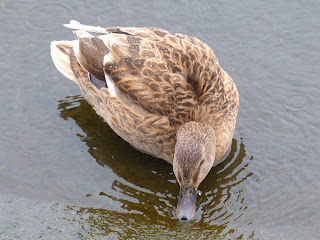Monday, 18 March 2013
On a dismal dark day of steady rain, the Little Owl surprised us by sitting in the open for several hours. It seemed to have lost its former fear of humans, though I didn't like to alarm it by going too close. We need to be very tactful with these birds if we are to see more of them.
Only a heavy hailstorm sent it inside the tree. This is an old sweet chestnut, one to the west of the chestnut tree in which the pair nested last year, and the second tree from the lakeside path. It seems quite likely from the owl's behaviour that the pair are nesting in this tree, and this is the male standing guard in front of the nest.
Two other people as well as myself made a wide search for the Tawny Owl family, and I think we would have seen them if they had come out. There was little reason for them to expose themselves to the miserable weather.
Thrushes actually like rain because it brings up worms, and there were plenty to see poking around in the grass. This Song Thrush is one of the pair that attacked the Carrion Crows yesterday.
A Blackbird was in full song high in a tree north of the Albert Memorial, and indeed the Blackbird whose nest is outside the window of my flat started singing yesterday.
Here is an unusually pale female Mallard on the Serpentine. Her colour would be described as 'brown' in the technical sense that she has less black eumelanin than normal, but the usual amount of reddish phaeomelanin.
But she has kept her proper markings, unlike the black and white Mallard, also female, in which the delicately balanced pattern-making mechanism has broken down. There is plenty of melanin, but it has concentrated in some places and is entirely missing in others.
Among ducks, Mallards seem uniquely prone to colour variations, and I wonder whether this is caused by genes from escaped white domestic ducks, which are descended from Mallard but have had their genetic makeup disturbed by inbreeding. There are several prevalent colour combinations, including pure white wild Mallards -- there was a white female on the Serpentine a few years ago -- almost pure black usually with a white neck ring and/or bib, and males with a mostly normal pattern but with their normal narrow white neck ring much widened and maybe also forming a bib. I would guess that the last of these are crosses between black and white birds and normal ones, as if the colour disturbance was being diluted.
Subscribe to:
Post Comments (Atom)




Dear Ralph,
ReplyDeleteI was intrigued by your musings on mallard colourations! There is a good site from the web which deals with duck genetics in relation to colour and patterning. Essentially the developmental and biochemical processes are similar in birds and mammals, with the exception being sex linked traits. In most mammals (with the notable exception of duck billed platypus which lays eggs and has a beak like structure) the male on X and one Y chromosome, the female has two X chromosomes. In birds it is the other way around, the male has two Z chromosomes, the female has one Z and one W chromosome. Some of the sex linked colourations such as the "diluted brown" gene causes a reduction in pigmentation is recessive and carried on the Z chromosome, and so ismuch more common in females than males, in the same way mammalian colour blindness is more common in males than females.
http://www.backyardchickens.com/t/410593/understanding-basic-colour-genetics-mallards-derivitives
Other factors such as neural crest migration problems which result in a failure of melanocytes to reach the dermis are also involved, and are the basis for piebaldness. Environmental and seasonal or circadian factors are also involved.
The blog is great and I check it daily as I am unable to visit the site as often as I would like.
all the best
Andy Sunters
Thanks very much for this interesting information. The site you mention is excellent and has cleared up a lot of things I was wondering about.
Delete